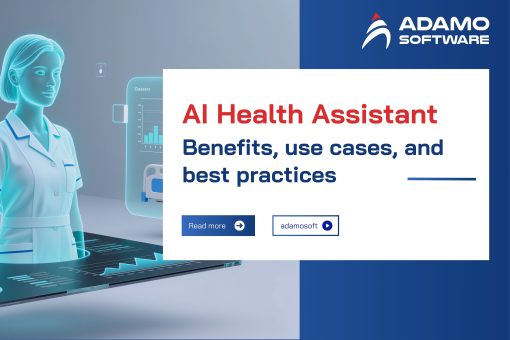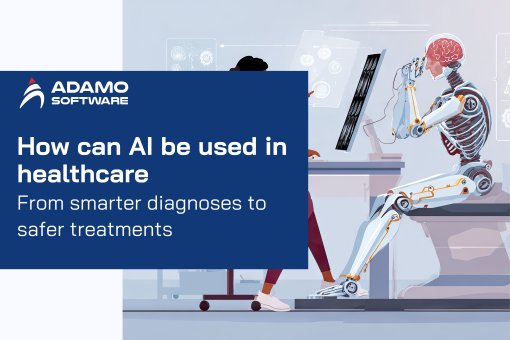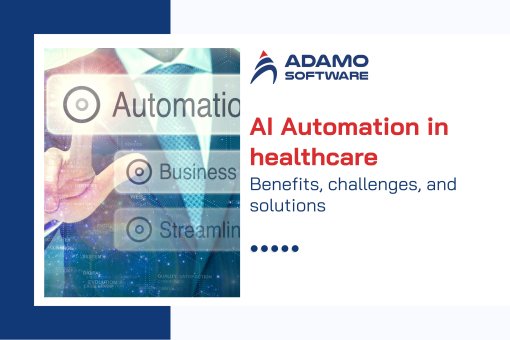Custom mHealth app development: Cost estimation and how to build
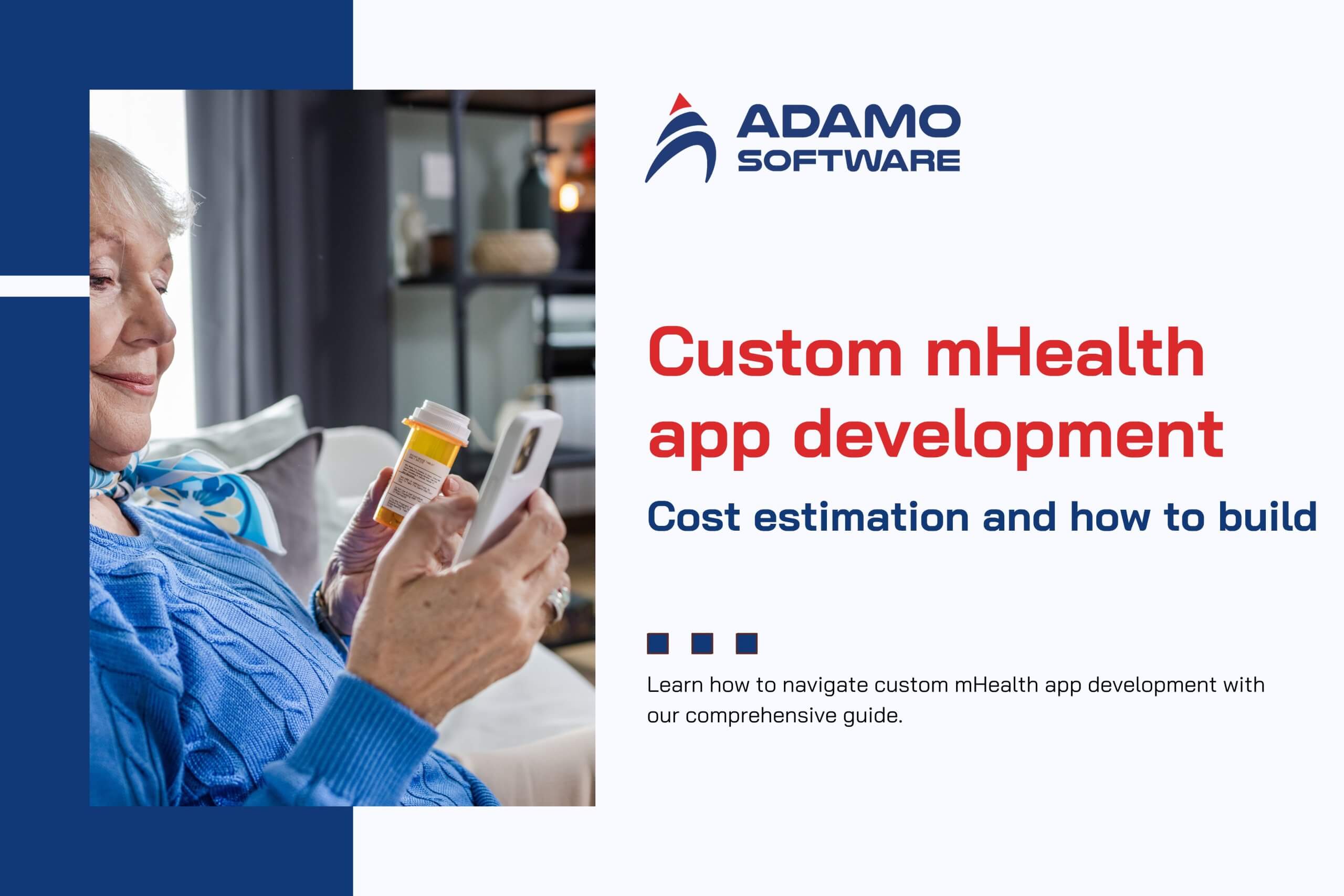
Demand for custom mHealth app development is increasing. Healthcare providers are constantly looking for innovative solutions to improve patient care. Creating a custom mHealth app can be a simple way to speed up services and raise user engagement.
However, an understanding of the costs involved is necessary for success. This article will tell you what you need to know to build a custom mHealth app from scratch. We’ll review the cost estimation and give you actionable steps to create your app.
The right approach allows you to build a tool that truly meets healthcare needs. Let’s examine custom mHealth app development and what it can do for you.
I. Costs breakdown of custom mHealth app development
One thing every healthcare business seeks to do is to cut costs and build a customer-centric custom health app. The total development costs depend on many factors. These factors may be analyzed, and you can balance quality and spending by understanding their impact on the budget.
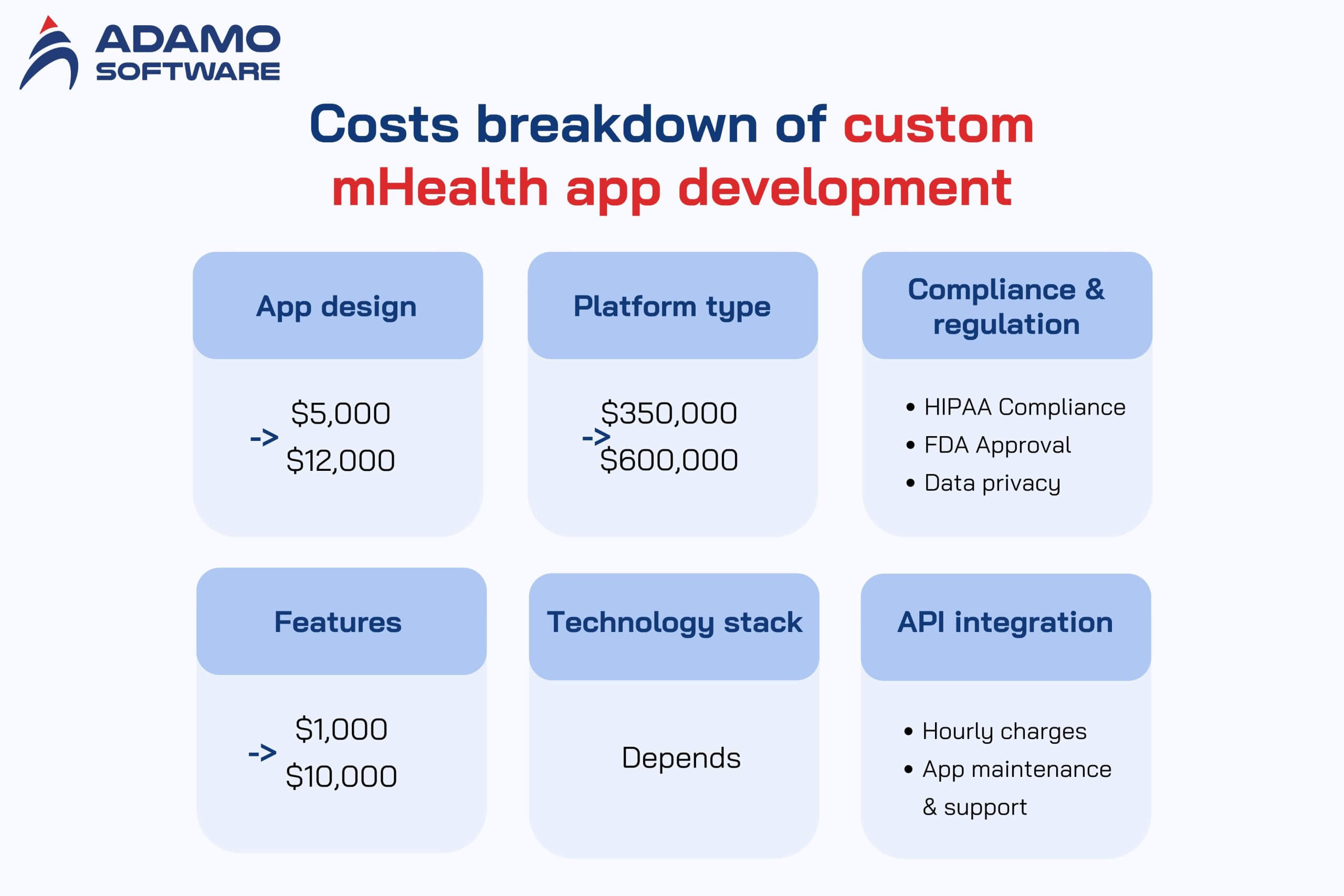
1. App design
Custom mHealth app development costs depend on your app design needs. Costs increase based on features such as graphic transitions and color effects, which require skilled developers to create. Usually, UI/UX design costs an average of $5,000 and up to $12,000.
2. Platform type
Custom mHealth app development is platform-dependent. Audience reach and cost are the result of platform choice. Hybrid apps cost you $600,000, while native apps start from $350,000 to $400,000.
3. Compliance and regulation
Custom mHealth app development is necessary but costly due to adherence to healthcare regulations. Key considerations include:
- HIPAA Compliance: Patients’ data must be secured following HIPAA standards when installed on healthcare apps.
- FDA Approval: Applications related to pharmaceutical services have to seek FDA approval.
- Data privacy: Following GDPR will ensure patient data protection and compliance meet the standards.
4. Features
The price of custom mHealth app development varies heavily in the digital healthcare industry, depending on the features you include in the app. Let’s explore the price range for integrating specific features in detail:
Push notifications and reminders – Push notifications are an easy way to build a strong relationship with your patients. Such opens additionally help users be on top of the healthcare tasks and get timely updates. A push notification system can range from $1,000 to $5,000 to add. On the more expensive side of this range, personalized notifications via AI can be purchased if you pick a subscription.
Appointment scheduler management – With many appointments, an effective appointment scheduler is necessary to handle those bookings. It also sends timely reminders, so users never miss a consultation. Depending upon its complexity, this feature may cost $1,000 to $2,500 to develop. It is the advanced functionality that pushes the cost higher.
Multi-user login – Browser extensions, social media accounts, and your app are possible channels for patients to log in. You need a robust interface that supports several users logging in safely to your app. Depending on the implementation, the development cost for supporting multi-user login functionality is typically between $4,000 and $10,000.
EHR management – Patient records are sent to doctors and hospital administrators to manage. An electronic health record (EHR) management system makes storing and retrieving patient data securely easy. The price tag for this feature ranges from $5,000 to $10,000 based on the complexity of the data management tools needed.
In-app chat – Healthcare apps often have features that enable doctors and patients to communicate. This feature allows patients to ask questions or doctors to monitor health updates. For this feature, integration costs can run from $5,000 to $10,000 based on basic chat functionality and other advanced functions, like AI chatbots.
In-app payment – Adding a multi-payment system makes payment processes for patients much easier. This enables the users to choose payment gateways, promoting user convenience. You can add this feature for under $3k to $7k; it depends on the number of payment methods you want to support.
5. Technology stack
Your technology stack is significant for custom mHealth app development costs. You may require more than one framework and programming tools depending on what your app has. That means you’ll need expert developers with robust hybrid app development expertise. Not surprisingly, advanced technology apps that utilize AI or IoT will require a special tech stack, which will bring costs up. These tools and technologies are crucial for a high-quality custom mHealth app development that is best suited to your needs.
6. API integration
The mHealth app must feature seamless API integration. It matters when your app contains dynamic features or depends on third-party services. In this case, experienced developers can write strong API code and have it connected seamlessly to your app’s core functions. Additionally, integration of API should be proper in a way to make your app work properly and reliably.
Hourly charges of app development – This plays a major role in custom mHealth app development. Rates of these vary depending on experience, skills, and geographic location. Rates are higher for North America and Europe as a rule compared to the rest of Asia. To control the costs without sacrificing quality, you must select developers that fit the budget and quality requirements.
App maintenance and support – Your custom mHealth app development needs to enjoy long-term success, and continuing maintenance and support of your mHealth app is very important. Whether you are developing a fitness app, a medical records app, or a telemedicine app, you’ll have to update the app’s features at a time. Apps with either basic or more advanced functionality require periodic enhancements. If your app is created with strong code in the beginning, then some of these costs can be cut down.
The maintenance cost of custom mHealth app development has several influencing factors. The complexity of your app and the experience of the IT support team are the two big ones. Fewer features will mean that the app will naturally cost less to maintain. However, extensive support for apps with more than simple integrations and basic functionality will be needed, making them more costly. With skilled IT support teams, you can ensure the app maintains itself while staying updated and efficient without overspending on maintenance.
Also read: What is a mHealth app? Market overview, benefits and current trends
II. A step-by-step Custom mHealth App Development Guide
Custom mHealth app development has its steps, as it follows many steps like other app development, such as fitness or messaging apps. However, healthcare apps have their own needs and compliance standards in the industry. A detailed breakdown of this process, focusing on healthcare-specific elements, can be seen below.
These steps may not always progress in a straightforward manner. They can be overlapped, simultaneous, or shifted as required for a project.

1. Create a strategic vision
Adopting a lean inception approach while custom mHealth app development starts is a great choice. This method integrates the app seamlessly and gains the most benefits.
First, you form a diverse team of stakeholders, such as product owners, developers, and designers. Over a one-to-two-week workshop, the team should:
- Come up with the app’s vision, goal, and success criteria.
- Representing the target audience using user persona and aligning features with the user needs.
- Rank features according to their importance and feasibility of them.
- Develop storyboards to visualize the user journey to improve app interaction.
- Sketch a roadmap with the MVP (minimum viable product) and divide it into tasks and milestones.
2. Choose a development approach and technologies
In custom mHealth app development, selecting the right development approach is critical. There are two primary ways to build apps: going native or using a cross-platform framework. Each of the strengths depends on your goals and resources.
Native Development
We create different app versions for iOS and Android in this approach while using platform-specific languages and tools.
Best for:
- High-speed data processing Apps that require apps with complex algorithms like AI or ML.
- Projects with bigger budgets and longer leads.
- Platform-specific UI/UX design for an app with a familiar user experience.
Cross-Platform Development
With such an approach, developers code once and deploy to all platforms.
Best for:
- Cutting down the cost of maintaining separate codebases when you have projects with limited budgets.
- Building MVPs quickly to test concepts, collect feedback & validate the market demand.
- Common applications with standard functionality that don’t require platform-specific features or heavy performance demands.
3. Design the app
Custom mHealth app development must be done so that it creates an engaging and seamless user experience. However, the success of a healthcare app depends on a well-structured app design process. Here’s a step-by-step approach to designing a mobile health app:
- User research and analysis: All this is to guide the app’s design with insights gathered through surveys, interviews, and usability testing. It identifies user needs and preferences, and the app matches target audiences.
- Information architecture: Organize the app’s features and content in a clear and logical manner. Architectural perfection helps navigation and user satisfaction.
- Wireframing and prototyping: Refining high-fidelity wireframes requires a prior step in visualizing design concepts using low-fidelity wireframes. It makes the app design clear and consistent.
- Visual design: Make sure to use color schemes, typography, and design elements to build a coherent and recognizable experience for the user. It should have a visual contribution that will appeal to healthcare professionals and patients.
- Responsive design: Optimize the app for different devices to give users the same experience across smartphones, tablets, and desktops.
- Interaction design: Include animations, micro-interactions, and user-friendly gestures to increase usability and user engagement.
- Design systems: Maintain consistency by developing scalable design systems to cover all app components and digital products.
- Accessibility: Build inclusivity into the app using features that will allow people with disabilities to use the app.
4. Mobile frontend and backend development along with QA
Frontend and backend development is done during the next phase of custom mHealth app development, followed by rigorous quality assurance.
Frontend development
Make it intuitive while focusing on the UI and avoid the pile of clicks. Concentrate on UX, which is a smooth and fun experience for the user. It includes usability testing to refine the interface to the best possible performance.
Backend development
The infrastructure server set up database management efficiently. It will strengthen your API to support app functionality and good communication between the front and back end.
Quality Assurance (QA)
QA is crucial for custom mHealth app development. It includes:
- Functionality Testing: Make sure that every feature works out as it should.
- Performance Testing: Speed, responsiveness, and reliability can be checked in the app.
- Security Testing: Ensure the app keeps your sensitive data safe from threats.
- User Acceptance Testing (UAT): Deploy the app only if it meets the user’s expectations.
5. Implement security standard
Robust security is an important part of custom mHealth app development. Sensitive personal data is what healthcare apps usually deal with, and security is out of the question. To protect user information effectively, data must be encrypted and connections secured.
The design and functionality of an app, or any part of it, vary based on the kind of app it is and who it’s meant for. Therefore, the developers might have to integrate different frameworks or abide by the medical software standards. These include:
- iOS HealthKit Integration and Android.os.health package for platform-specific features.
- For international medical software standards, ISO27001 or IEC 62304.
- Enhanced data protection with compliance with the HITECH Act.
On top of these frameworks, custom mHealth app development must meet regional government security regulations. Examples include:
- HIPAA – USA: Provides security to PHI data. Also, remember that personal health apps may be out of the scope of HIPAA.
- Personal Information Protection and Electronic Documents Act (PIPEDA) (Canada): Controls how personal data is used and shared.
- General Data Protection Regulation (GDPR) (EU): Rules on handling identifiable personal data, including names and IP addresses.
- Data Protection Act (DPA) (UK): Mirrors GDP and adds region-specific guidance on storing and using personal data.
What if the mobile health app is created in some other regions? In that case, it should be developed in a region where it collects user data according to that region’s privacy and security standards. It fosters user trust and helps avoid legal complications.
6. App launch and maintenance
Launching and maintaining the custom mHealth app is the final step of custom mHealth app development. It’s important to pick a good hosting service, like AWS or DigitalOcean, for your free hosting experience and secure and scalable file storage before launch. These services are cheap and trusted worldwide by developers.
The approval process of the Google Play Store or Apple App Store will need to be prepared for the targeted apps. That includes signing agreements with Google and Apple, meeting their submission guidelines, and offering us that level of support.
Once the app is launched, app maintenance becomes very important to keep the app working and updated. Developers are working on isolated environments to develop updates and don’t break the live app. Updates go through rigorous testing before the update is deployed to production. Doing this helps to maintain stability, and your app should perform well, if only over time.
You want your partner to be skilled and reliable to avoid having a smooth launch and effective maintenance. They will have the expertise to do all of the custom mHealth app development part well, from compliance to maintenance.
III. Tips to reduce budget for mHealth app development services
For a simple custom healthcare app, the cost can be anywhere from $100,000-$200,000, which will rise with more features. Here are some tips to reduce your custom mHealth app development costs:
1. Minimize wearable device integrations
The more wearables devices you add, the more you’ll have to pay for development. Each sensor needs more work and licensing fees. If you need to integrate wearables, do your best to minimize the amount to avoid exponential development time and costs.
2. Opt for unified communication protocol
If your app connects to several devices, their communication protocol must be the same. Your development team can write integration code once, saving time and costs.
3. Choose FHIR and HL-7-compliant solutions
If integrating with hospital systems, like electronic health records, go with FHIR and HL-7 compliant. Integration is simplified, and custom development is avoided.
4. Go for open-source tools
Open-source tools such as OpenCDS can save you money as they perform the integration and business rule engine function. It’s a tool that lets doctors define rules and send reminders without creating a bespoke solution from scratch.
5. Avoid AI in the initial stages
Consider starting with heuristics (simple, hard-coded algo) instead of AI features. It’s cheaper and lets you prove the concept before laying down hard cash on the more advanced AI later.
6. Focus on compliance standards that matter
Only focus on meeting the regulations that you need in your country. Trying to meet global standards can lead to cost increases without adding value to your app.
7. Tailor the app to your target audience
Your app will become what your audience needs it to be. For instance, apps for seniors need accessibility features, whereas apps for younger ones may not require other measures.
8. Choose the right platform
When you can use cross-platform development instead of native, do so. That will avoid the costs of native development except when you need tight integration with hardware.
9. Focus on core features for MVP
To get to market faster and drop the initial cost, focus on core features that meet basic user needs. Later, when the app starts growing, you can add some more functions.
IV. Why Adamo is your ideal partner for the savvy mHealth app development

Your custom mHealth app development project will be elevated with the help of Adamo Software. Our team has extensive experience providing customized solutions tailored to your healthcare needs. We make user-friendly designs that promote patient engagement and simplify communication.
Our custom mHealth app development has features like appointment scheduling and remote monitoring and can be integrated smoothly. Data security and compliance with health care regulations are also our top priorities, as they protect patient information. Should you choose Adamo, you will have a trusted partner committed to developing high-quality healthcare solutions that will make a difference.







